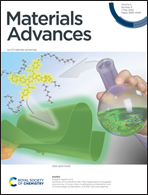Inverse photochromism in viologen–tetraarylborate ion-pair complexes: optical write/microwave erase switching in polymer matrices†
Abstract
With the aim to construct a new type of photoswitchable photochromic material modulated by specific radiation in the microwave region, the spin dynamics of radical pairs (RPs) from ion-pair complexes between viologen and tetraarylborate compounds have been investigated in the presence of microwave (μw) radiation, using steady-state electron paramagnetic resonance (SSEPR) to follow the radical pair (RP) dynamics. This strategy is realized by excitation of the charge transfer (CT) absorption band of the ion-pair complex in the solid phase (powders and dispersed in polymer matrices) at 410 nm, which leads to electron transfer from borate to viologen, producing RPs. In the singlet excited state or Partially Separated Charge (PSC) state, an electron transfer process occurs between the ions, and the subsequent (purple) viologen radical is observed as a Fully Charge Separated (FCS) state. In solid state SSEPR experiments, μw radiation deactivates the FSC state by inducing back electron transfer, which subsequently increases the population of a Partially Separated Charge (PSC) state, recovering the initial color of the ion-pair complex. State-of-the-art photophysical and photochemical studies show that deactivation of the FSC state can take place using μw radiation on the RPs in a switchable, reversible fashion. The results have potential impact for a number of applications including photo-writing and photo-erasing processes and spintronics. Examples of laser writing using a polymer matrix to lock the relative positions of the radicals, and then erasing the color using microwaves, are presented and discussed.



 Please wait while we load your content...
Please wait while we load your content...